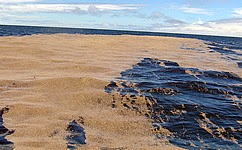Scientists have used a computer model of ocean circulation to predict the movement of the rafts of floating pumice given off by an erupting underwater volcano.
These rafts can cause problems for ships, so the researchers hope their work will lead to the development of early-warning systems to let mariners avoid risky areas in the wake of an eruption.
The researchers used NEMO, the UK’s high-resolution model of ocean circulation, to represent the ocean currents around Havre, a volcano deep under the southwest Pacific that erupted in July 2012. They then used its output to calculate the movements of thousands of particles representing areas of drifting pumice.
Finally, they compared the results with what satellite images and sailors’ sightings tell us actually happened. The match was encouragingly close, showing that although it needs more development the technique is capable of accurately predicting the movement of these floating islands.
‘The eruption was far from coastal interference, so it produced a single raft spanning over 400km2 in one day, initiating a gigantic, high-precision natural experiment in surface dispersion,’ says Dr Bob Marsh of the University of Southampton.
He was part of a team led by Dr Martin Jutzeler of the National Oceanography Centre, which recently published their findings in Nature Communications. ‘It’s only recently that we’ve had oceanographic models that represent how things spread out in the ocean accurately enough to do this kind of thing, so it’s a big opportunity for new research,’ Marsh adds.
His methods can be used to predict the movement of any floating objects that are carried about the ocean by currents – he’s already applied them to everything from debris associated with accidents to icebergs and baby turtles. Although NEMO itself needs to run on national supercomputers, the additional calculations he performs based on its output can be done in mere hours on normal computing hardware, allowing scientists to respond quickly to natural disasters.
‘If we see a big undersea volcanic eruption, we can react within 24-48 hours to produce maps of where pumice will drift to over time,’ he says. ‘All we need to know is where the volcano is.’
Pumice rafts are mostly made up of tiny pieces of floating rock, less than a centimetre across, so in most cases they aren’t likely to breach a ship’s hull. They can endanger its ability to keep moving, though, for example by clogging up water intakes so that engines have no cooling and overheat. ‘It’s not like an iceberg that can sink the ship, but it could effectively cordon off a large area of ocean for several weeks, which could cost the maritime industry a lot of money,’ Marsh says.
He now hopes to work with the shipping and marine insurance industries, as well as with colleagues in the Met Office, to investigate whether these techniques can be turned into a useful information service for sailors – perhaps an add-on to the Met Office’s existing services. He is already working on developing an early-warning system for icebergs, and says it would be relatively easy to incorporate pumice raft forecasting.
More information: “On the fate of pumice rafts formed during the 2012 Havre submarine eruption.” Martin Jutzeler, Robert Marsh, Rebecca J. Carey, James D. L. White, Peter J. Talling & Leif Karlstrom. Nature Communications 5, Article number: 3660. DOI: 10.1038/ncomms4660
Note : The above story is based on materials provided by PlanetEarth Online










